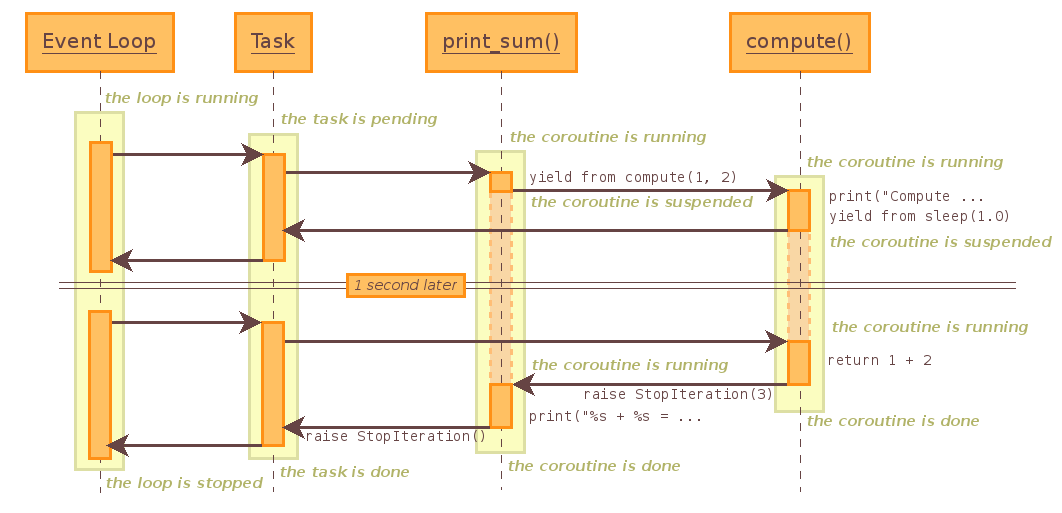https://www.jianshu.com/p/84df78d3225a#yield-from表达式
-
GIL
全局解释器锁(英语:Global Interpreter Lock,缩写GIL),是计算机程序设计语言解释器用于同步线程的一种机制,它使得任何时刻仅有一个线程在执行。
即便在多核心处理器上,使用 GIL 的解释器也只允许同一时间执行一个线程。 -
协程
协程,又称微线程,纤程,英文名Coroutine。协程的作用,是在执行函数A时,可以随时中断,去执行函数B,然后中断继续执行函数A(可以自由切换)。
但这一过程并不是函数调用(没有调用语句),这一整个过程看似像多线程,然而协程只有一个线程执行.
Python3.4之前,官方没有对协程的支持,存在一些三方库的实现,比如gevent和Tornado。
3.4之后就内置了asyncio标准库,官方真正实现了协程这一特性。而Python对协程的支持,是通过Generator实现的,协程是遵循某些规则的生成器。
- 生成器:
def test():
print("generator start")
n = 1
while True:
yield_expression_value = yield n
print("yield_expression_value = %d" % yield_expression_value)
n += 1
# ①创建generator对象
generator = test()
print(type(generator))
print("
---------------
")
# ②启动generator
next_result = generator.__next__()
print("next_result = %d" % next_result)
print("
---------------
")
# ③发送值给yield表达式
send_result = generator.send(666)
print("send_result = %d" % send_result)
'''
1. __next__()方法: 作用是启动或者恢复generator的执行,相当于send(None)
2. send(value)方法:作用是发送值给yield表达式。启动generator则是调用send(None)
3. 生成器启动或恢复执行一次,将会在yield处暂停。上面的第②步仅仅执行到了yield n,并没有执行到赋值语句,到了第③步,生成器恢复执行才给yield_expression_value赋值。
'''
- 生产者消费者模型(整个流程无锁,由一个线程执行,produce和consumer协作完成任务,所以称为“协程”,而非线程的抢占式多任务。)
def consumer():
print("[CONSUMER] start")
r = 'start'
while True:
n = yield r
if not n:
print("n is empty")
continue
print("[CONSUMER] Consumer is consuming %s" % n)
r = "200 ok"
def producer(c):
# 启动generator
start_value = c.send(None)
print(start_value)
n = 0
while n < 3:
n += 1
print("[PRODUCER] Producer is producing %d" % n)
r = c.send(n)
print('[PRODUCER] Consumer return: %s' % r)
# 关闭generator
c.close()
# 创建生成器
c = consumer()
# 传入generator
producer(c)
- yield from 思想
# 1
# 子生成器
def test(n):
i = 0
while i < n:
yield i
i += 1
# 委派生成器
def test_yield_from(n):
print("test_yield_from start")
yield from test(n)
print("test_yield_from end")
for i in test_yield_from(3):
print(i)
'''
test_yield_from start
0
1
2
test_yield_from end
'''
# 2
# 如果上面的test_yield_from函数中有两个yield from语句,将串行执行。test_yield_from函数改写成这样:
def test_yield_from(n):
print("test_yield_from start")
yield from test(n)
print("test_yield_from doing")
yield from test(n)
print("test_yield_from end")
将输出:
'''
test_yield_from start
0
1
2
test_yield_from doing
0
1
2
test_yield_from end
'''
# yield from起到的作用相当于下面写法的简写形式 (它还帮我们处理了异常之类的)
for item in test(n):
yield item
- Python3.4中,使用@asyncio.coroutine 和yield from 实现协程
# @asyncio.coroutine源码简化
import functools
import types
import inspect
def coroutine(func):
# 判断是否是生成器
if inspect.isgeneratorfunction(func):
coro = func
else:
# 将普通函数变成generator
@functools.wraps(func)
def coro(*args, **kw):
res = func(*args, **kw)
res = yield from res
return res
# 将generator转换成coroutine
wrapper = types.coroutine(coro)
# For iscoroutinefunction().
wrapper._is_coroutine = True
return wrapper
# 我们来使用 @asyncio.coroutine 和 yield from:
import asyncio
@asyncio.coroutine
def compute(x, y):
print("Compute %s + %s ..." % (x, y))
yield from asyncio.sleep(1.0)
return x + y
@asyncio.coroutine
def print_sum(x, y):
result = yield from compute(x, y)
print("%s + %s = %s" % (x, y, result))
loop = asyncio.get_event_loop()
print("start")
# 中断调用,直到协程执行结束
loop.run_until_complete(print_sum(1, 2))
print("end")
loop.close()
'''
start
Compute 1 + 2 ...
1 + 2 = 3
end
'''

- Python3.5开始引入async/await语法,async/await实际上只是@asyncio.coroutine和yield from的语法糖:
把@asyncio.coroutine替换为async
把yield from替换为await
import asyncio
async def compute(x, y): # @asyncio.coroutine替换为async
print("Compute %s + %s ..." % (x, y))
await asyncio.sleep(1.0) # 把yield from替换为await
return x + y
async def print_sum(x, y): # @asyncio.coroutine替换为async
result = await compute(x, y) # 把yield from替换为await
print("%s + %s = %s" % (x, y, result))
loop = asyncio.get_event_loop()
print("start")
loop.run_until_complete(print_sum(1, 2))
print("end")
loop.close()
- asyncio中Future的例子
import asyncio
future = asyncio.Future()
async def coro1():
print("wait 1 second")
await asyncio.sleep(1)
print("set_result")
future.set_result('data')
async def coro2():
result = await future
print(result)
# 1.
loop = asyncio.get_event_loop()
loop.run_until_complete(asyncio.wait([
coro1()
coro2()
]))
loop.close()
# 2. 结果和1 一样,await future 必须要等待future.set_result('data')后才能够结束。将coro2()作为第二个协程可能体现得不够明显,可以将协程的调用改成这样:
loop = asyncio.get_event_loop()
loop.run_until_complete(asyncio.wait([
# coro1(),
coro2(),
coro1()
]))
loop.close()